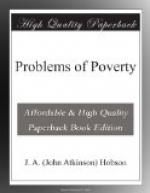Since however the scheme of Mr. C. Booth does not proceed beyond the stage of a suggested outline of treatment, it is not fair or profitable to press close criticism. It is, however, a fact of some significance that one who has brought such close study to bear upon the problem of poverty should arrive at the conclusion that “Thorough interference on the part of the State with the lives of a small fraction of the population, would tend to make it possible, ultimately, to dispense with any Socialistic interference in the lives of all the rest."[33]
Sec. 5. Proposed remedies for “Unemployment.”—In discussing methods of dealing with “the unemployed,” who represent an “over-supply” of labour at a given time, it is often found convenient to distinguish the temporary “unemployment” due to fluctuations rising from the nature of certain trades, and the permanent unemployment or half employment of large numbers of the least efficient town workers. The fluctuations in employment due to changes of season, as in the building trades, and many branches of dock labour, or to changes of fashion, as in the silk and “fancy” woollen trade, or to temporary changes in the field of employment caused by a transformation of industrial processes, are direct causes of a considerable quantity of temporary unemployment. To these must be added the unemployment represented by the interval between the termination of one job and the beginning of another, as in the building trades. Lastly, the wider fluctuations of general trade seem to impose a character of irregularity upon trade, so that the modern System of industry will not work without some unemployed margin, some reserve of labour.
These irregularities and leakages seem to explain why, at any given time, a certain considerable number of fairly efficient and willing workmen may be out of work. It is often urged that this class of “unemployed” must be regarded as quite distinct from the superfluity of low-skilled and inefficient workers found in our towns, and that the two classes present different problems for solution. The character of the “chronic” class of unemployed makes the problem appear to be, not one of economic readjustment, but rather of training and education. But this appearance is deceptive. The connection between the two kinds of “unemployment” is much closer than is supposed. The irregularity of the “season” and “fashion” trades, the periodic spells of bad trade, are continually engaged in degrading and deteriorating the physique, the morale, and the industrial efficiency of the weaker members of each trade: these weaklings are unable to maintain a steady and healthy standard of life under economic conditions which make work and wages irregular, and are constantly dropping out of the more skilled trades to swell the already congested low-skilled labour market. Every period of “depressed trade” feeds the pool of low-skilled labour from a hundred different channels. The connection between the two classes of “unemployed” is, therefore, a close and vital one. To drain off this pool would, in fact, be of little permanent use unless those irregularities of trade, which are constantly feeding it, are also checked.




